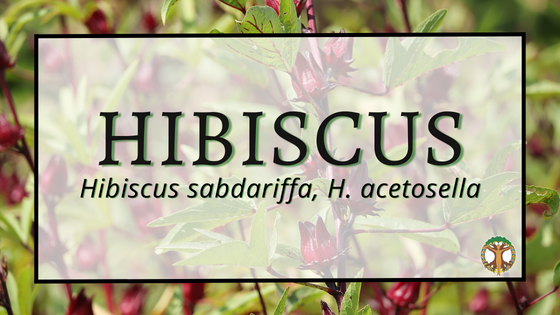
Hibiscus
Common Names: Hibiscus, Jamaica, Roselle, Cranberry Hibiscus, Sorrel, Florida Cranberry, Isapa, Yakuwa, Gurguzu, Flor de Jamaica
Latin name: Hibiscus sabdariffa; H. acetosella
Family: Malvaceae
Habitat: Hibiscus is a perennial shrub in tropical climates and a frost-tender annual in temperate regions. It thrives in warm weather. It is native to West and East Africa and parts of Southeast Asia, including Northeastern India. It grows 4-8 feet tall with leaves that are deeply three- to five-lobed, 3-6 inches long, and arranged alternately on the stems. Hibiscus flowers are 3-4 inches in diameter, ranging from white to yellow to pink with dark red at the base of each petal. While the leaves and flowers of hibiscus are edible, the medicine of this plant is found in its calyx (plural calyces), stout and fleshy coverings at the base of each flower that turn bright red and surrounded the seed pod as it matures.
Growth: Since it’s used for fiber and cordage, you can expect this plant to get tall and woody unless kept pruned. Forms a gorgeous hedge, especially the red leaf variety, H. acetosella. Will grow aimlessly and sprawl unless kept pruned.
Energetics: Hibiscus calyces are sour and cooling.
Benefits: The calyces of hibiscus are rich in Vitamin C, and have a history of medicinal use to reduce blood pressure, alleviate symptoms of heat exhaustion, and support the immune system. Plus, the tart and tangy flavor makes a great addition to other herbal infusions to make them more palatable.
Beverage: Hibiscus is well known as a regional beverage throughout the Caribbean, made from the calyces after the seed pods have been removed. The calyx is boiled or infused, typically with a mix of spices such as cloves, cinnamon, or nutmeg, and often served chilled. Many island nations enjoy this beverage with a splash of rum. It is known as sorrel or jamaica depending on the region. Middle Eastern and Sudanese “Karkade” is a cold drink prepared by soaking the calyces in water overnight and adding sugar or lemon.
Food: Hibiscus makes a delicious infusion but is also known for it’s food preparations. Leaves can be enjoyed in salads or steamed like spinach, and are cooked with chiles and garlic to make a chutney in some Indian and SE Asian cultures. The calyces are collected for a tart beverage and often blended into a chutney in parts of Asia. Calyces are a collection of sepals, at the base of the flower. Once the flower has fallen off, the calyx will close and then you can harvest. Inside the calyx is a mucilaginous seed – it’s up to you whether you include that or not. Herbalist Juliet Blankespoor leaves some of them in.
Stalk: can be used for fiber, similar to jute.
Recipes: Juliet Blankespoor’s Hibiscus Pomegranate Fire Cider
a few Christmases ago I made a hibiscus, cranberry, cilantro, jalapeno, orange juice sort of slaw with a tiny bit of brown sugar and it was a big hit! I wish I remember the measurements, but I just chopped everything fine and threw it in a serving dish!
Hibiscus is a good ally to us in Florida because it will grow year-round, and flowers in the winter months! It is a profuse fruiter, and if you have the patience for harvesting and garbling, is a great economical addition to the garden. Drinking hibiscus tea has been shown to lower blood pressure [1], as if you needed a reason to drink this delicious tart beverage beyond its refreshing flavor.
!!! Important to note, from herbalist Juliet Blankespoor, “Please only use this species of hibiscus (Hibiscus sabdariffa), as other species aren’t necessarily edible and definitely aren’t used in the same fashion. (This is why proper identification and understanding of scientific names is important if you’re going to harvest your own medicine!)” !!! [2]
Hibiscus here in Central Florida is commonly found with mealybugs – look out for white spots on the plant! Check this link out for information on how to deal with mealybugs.
Sources:






